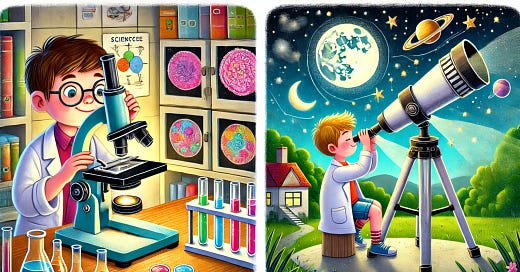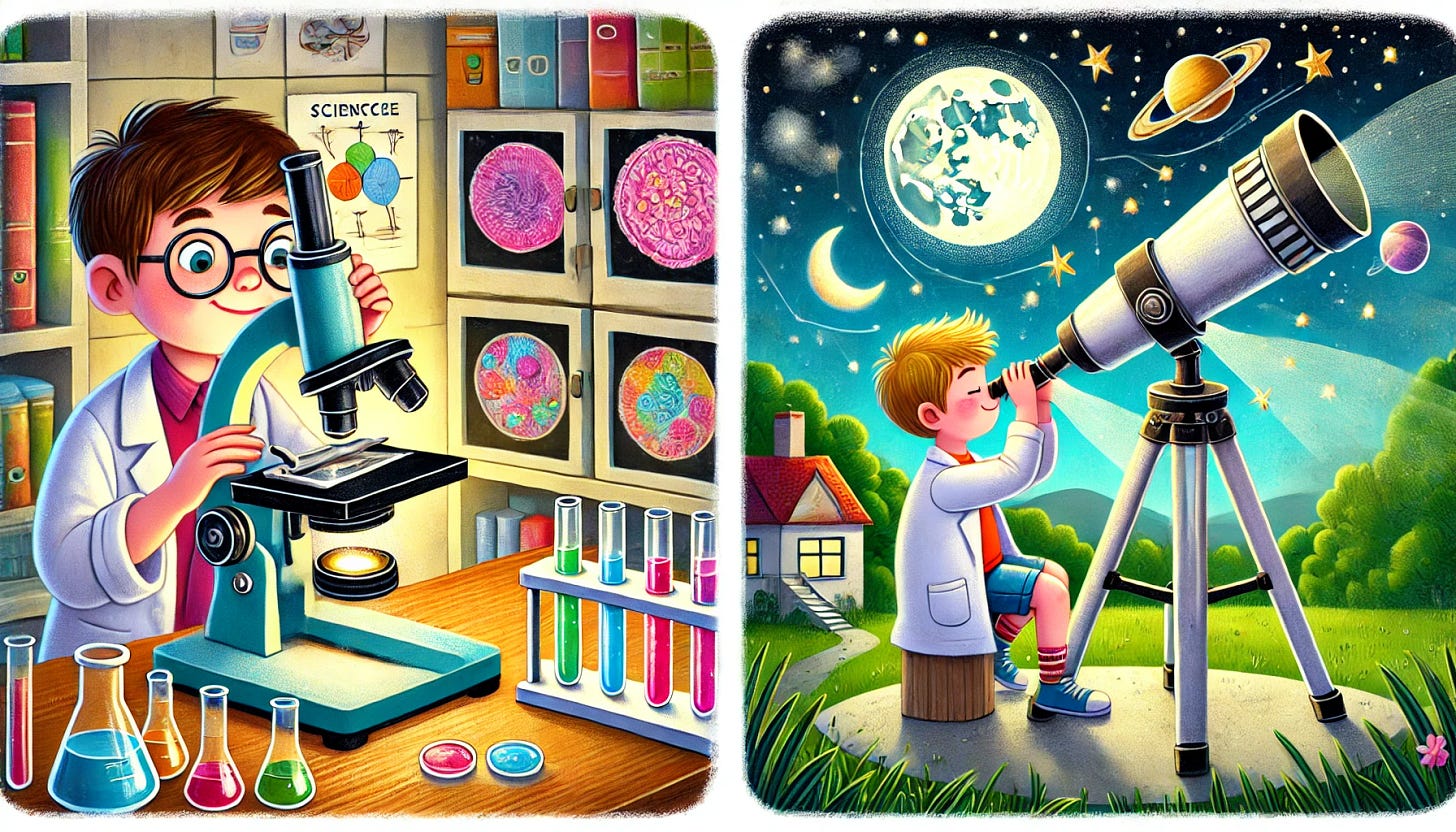How Do Microscopes and Telescopes Work, and How Are They Different?
Imagine you’re a scientist or an explorer. You want to see things that are super tiny, like the cells in your body, or things that are very far away, like stars in the night sky. How do you do that? You use special tools called microscopes and telescopes! These amazing instruments let us look at worlds that are too small or too far away to see with just our eyes. Let’s dive into how they work and discover what makes them different and unique!
Hello my friends!
For a quick note, welcome to Tidbits with Titus, a podcast and newsletter where we tackle the big, curious questions kids ask every day in fun, bite-sized ways! I’m Alexander Titus, but I go by Titus. I’m a scientist, adventurer, and a huge fan of making science, technology, and life accessible to all ages. From “How does electricity work?” to “What are taxes?” and even “Why is the sky blue?” I’m here to dive into these wonder-filled questions with engaging stories and simple explanations that spark curiosity and make learning a joy. This effort is all about creating a space where families can learn together, discover the magic of the every day, and find thoughtful ways to explore the world’s big mysteries. Let’s make curiosity a family tradition—one tidbit at a time!
Just so you know, these podcast episodes are all AI-generated using Google’s really cool NotebookLM technology. That means there are some errors in how words are said, but that is part of the fun!
If your little ones have questions that you want help answering, shoot me an email at questions@tidbitswithtitus.com and I’ll see what I can do!
You can subscribe to the newsletter that has this information as well at tidbitswithtitus.com.
Also please share with anyone you think would be interested. The more the merrier!
Cheers,
-Titus
What is a Microscope?
A microscope is like a magic magnifying glass. It helps you see things that are so small you can’t see them with your eyes. Scientists use microscopes to look at cells, bacteria, tiny bugs, and even grains of sand up close. Let’s find out how a microscope works!
How Does a Microscope Work?
Lenses Are the Key A microscope uses lenses to make small things look bigger. A lens is a piece of glass or plastic that bends light. When light passes through the lenses in a microscope, it magnifies the object you’re looking at. The more the light bends, the bigger the object looks.
Light Brings the Picture to Life Most microscopes need light to work. The light shines through or onto the object, making it easier to see details. Without light, everything would look dark and blurry.
Two Types of Lenses
Eyepiece Lens: This is the lens you look through at the top of the microscope.
Objective Lens: This lens is near the object you’re looking at. Some microscopes have more than one objective lens, so you can zoom in closer by switching lenses.
Stage and Slides The stage is where you place the object you want to look at, usually on a small glass slide. The slide keeps the object steady so it’s easier to focus on.
Cool Things You Can See with a Microscope
Cells: The tiny building blocks that make up all living things.
Insects: See the hairs on a fly’s legs or the scales on a butterfly’s wing.
Water Drops: Discover tiny creatures swimming in a drop of pond water.
What is a Telescope?
A telescope is like a giant eye that can see far into space. Astronomers use telescopes to look at stars, planets, galaxies, and even comets. Let’s explore how a telescope works!
How Does a Telescope Work?
Lenses or Mirrors Gather Light Telescopes collect light from faraway objects and bring it into focus. There are two main types of telescopes:
Refracting Telescope: Uses lenses to bend light.
Reflecting Telescope: Uses mirrors to reflect and focus light.
Making Distant Things Look Closer When light from a star or planet enters a telescope, the lenses or mirrors make the object appear much closer than it really is. This helps us see details, like the craters on the moon or the rings around Saturn.
The Eyepiece Brings the Image to You Just like a microscope, a telescope has an eyepiece lens that lets you see the magnified image.
Mounts Keep It Steady Telescopes sit on mounts that keep them steady. Some even have motors to follow stars as they move across the night sky.
Amazing Things You Can See with a Telescope
Planets: Spot Jupiter’s moons or Mars’ red surface.
Stars: Look at stars that are millions of light-years away.
Galaxies: Discover swirling collections of stars, like the Milky Way.
How Are Microscopes and Telescopes Similar?
Even though microscopes and telescopes are used to see very different things, they have a lot in common. Here’s how they are alike:
They Use Lenses Both tools use lenses (or mirrors) to bend light and make things look bigger or closer.
They Magnify Microscopes magnify tiny objects, and telescopes magnify faraway objects. They both help us see things we can’t see with our eyes alone.
They Need Light Light is essential for both instruments. Microscopes use light from a lamp, while telescopes collect light from stars, planets, or the sun.
They Help Us Explore Both tools let us explore worlds we couldn’t see otherwise. Microscopes reveal the hidden world of the tiny, and telescopes show us the vastness of space.
How Are Microscopes and Telescopes Different?
Even though they are similar, microscopes and telescopes are built for very different jobs. Here’s how they are different:
What They Look At
Microscopes are for tiny things, like cells and bacteria.
Telescopes are for faraway things, like stars and planets.
How They Gather Light
Microscopes shine light on or through the object being studied.
Telescopes gather light from distant objects in space.
Size
Microscopes are small and can fit on a desk.
Telescopes can be very large, especially ones used in observatories.
Field of View
Microscopes focus on tiny areas at a time.
Telescopes can view large areas of the night sky.
Fun Experiments to Try
Here are some fun activities to help you understand microscopes and telescopes:
1. Make Your Own Microscope
You can use a magnifying glass to make a simple microscope. Place a drop of water on a piece of clear plastic and look at it through the magnifying glass. Can you see tiny details?
2. Build a Pinhole Telescope
Take an empty paper towel roll and cover one end with aluminum foil. Poke a tiny hole in the foil, and look through the other end. Point it at a bright star. This simple telescope will give you a tiny glimpse of the night sky.
3. Observe Everyday Objects
Use a magnifying glass to look at things like leaves, coins, or even your own skin. Notice all the tiny details you can see.
4. Star Gazing
Go outside on a clear night and look at the stars. Use binoculars or a small telescope to see if you can spot the moon’s craters or a bright planet.
Why Are Microscopes and Telescopes Important?
Microscopes and telescopes help us learn more about the world around us. Here’s why they matter:
Microscopes: Teach us about health, nature, and how living things work. They help scientists study diseases and create medicines.
Telescopes: Help us understand space, our planet, and the universe. They let us explore the stars and planets without leaving Earth.
In Conclusion
Microscopes and telescopes are like magical tools that let us see the unseen. Microscopes show us the tiny, hidden details of our world, while telescopes take us on a journey through the vastness of space. Both are amazing in their own ways and help us discover new things every day. Whether you’re peering into a microscope or gazing through a telescope, you’re exploring the wonders of the universe. How cool is that?














Share this post